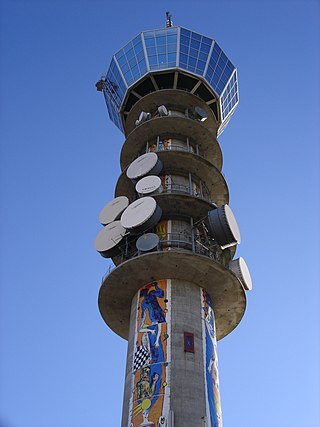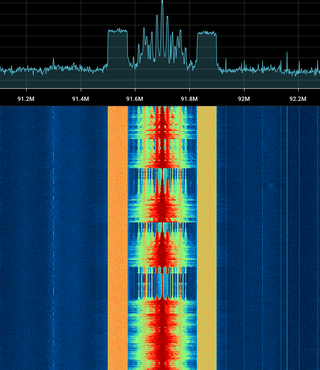History
Founded by Rohit Jagessar, an Indo-Guyanese American, RBC Radio began broadcasting on March 15, 1989. The first Asian-Indian radio station in the US, its first broadcasts were on PanAmSat Satellites (Intelsat) SAT COM R3, transponder 16 and on the 92 kHz subcarrier WNYE-FM, before moving to the 92 kHz subcarrier signal of The New York Times WQXR-FM, as well as on the AfriStar and AsiaStar Satellites covering four continents.
The station's rise in popularity in the Greater New York market took place mainly after it was launched on the New York Times subcarrier signal. It soon became the home for both Bollywood and Indo Caribbean artists to promote their latest films and music.
Maine Pyar Kiya, Dilwale Dulhania Le Jayenge, Hum Aapke Hain Koun, Kuch Kuch Hota Hai, Kabhi Khushi Kabhie Gham and Kaho Na Pyar Hai, are some of the most noted Bollywood film music that made their US debut on the station.
In addition to film music, hit songs such as Paree Hoon Mein, Made in India, San Ni Dha Pa, Bolo Ta Ra Ra, Vande Mataram and Sifir all had their US debut on the station.
Some of the singers that appeared in features and interviews on the station are Suneeta Rao, A. R. Rahman, Daler Mehndi, Sundar Popo, Alisha Chinai, Asha Bhosle, Kanchan, Sonu Nigam, Alka Yagnik, Rahat Fateh Ali Khan, Runa Laila, Kumar Sanu, Kavita Krishnamurti, Musarrat Nazir, Shaan, Udit Narayan, Amitabh Bachchan, Shankar Mahadevan, Hariharan and Jagjit Singh.
The station broadcasts in English, Hindi, Urdu, Bengali, Gujarati and Punjabi languages.
Mr. Rohit Jagessar has produced and hosted 37,960 hours of broadcasts for the station.

The first American standard for analog television broadcast was developed by the National Television System Committee (NTSC) in 1941. In 1961, it was assigned the designation System M.

Radio broadcasting is the broadcasting of audio (sound), sometimes with related metadata, by radio waves to radio receivers belonging to a public audience. In terrestrial radio broadcasting the radio waves are broadcast by a land-based radio station, while in satellite radio the radio waves are broadcast by a satellite in Earth orbit. To receive the content the listener must have a broadcast radio receiver (radio). Stations are often affiliated with a radio network that provides content in a common radio format, either in broadcast syndication or simulcast, or both. Radio stations broadcast with several different types of modulation: AM radio stations transmit in AM, FM radio stations transmit in FM, which are older analog audio standards, while newer digital radio stations transmit in several digital audio standards: DAB, HD radio, DRM. Television broadcasting is a separate service that also uses radio frequencies to broadcast television (video) signals.
Radio Data System (RDS) is a communications protocol standard for embedding small amounts of digital information in conventional FM radio broadcasts. RDS standardizes several types of information transmitted, including time, station identification and program information.
In-band on-channel (IBOC) is a hybrid method of transmitting digital radio and analog radio broadcast signals simultaneously on the same frequency. The name refers to the new digital signals being broadcast in the same AM or FM band (in-band), and associated with an existing radio channel (on-channel). By utilizing additional digital subcarriers or sidebands, digital information is "multiplexed" on existing signals, thus avoiding re-allocation of the broadcast bands.
A subcarrier is a sideband of a radio frequency carrier wave, which is modulated to send additional information. Examples include the provision of colour in a black and white television system or the provision of stereo in a monophonic radio broadcast. There is no physical difference between a carrier and a subcarrier; the "sub" implies that it has been derived from a carrier, which has been amplitude modulated by a steady signal and has a constant frequency relation to it.

The FM broadcast band is a range of radio frequencies used for FM broadcasting by radio stations. The range of frequencies used differs between different parts of the world. In Europe and Africa and in Australia and New Zealand, it spans from 87.5 to 108 megahertz (MHz) - also known as VHF Band II - while in the Americas it ranges from 88 to 108 MHz. The FM broadcast band in Japan uses 76 to 95 MHz, and in Brazil, 76 to 108 MHz. The International Radio and Television Organisation (OIRT) band in Eastern Europe is from 65.9 to 74.0 MHz, although these countries now primarily use the 87.5 to 108 MHz band, as in the case of Russia. Some other countries have already discontinued the OIRT band and have changed to the 87.5 to 108 MHz band.
Digital radio is the use of digital technology to transmit or receive across the radio spectrum. Digital transmission by radio waves includes digital broadcasting, and especially digital audio radio services.
Second audio program (SAP), also known as secondary audio programming, is an auxiliary audio channel for analog television that can be broadcast or transmitted both over-the-air and by cable television. Used mostly for audio description or other languages, SAP is part of the multichannel television sound (MTS) standard originally set by the National Television Systems Committee (NTSC) in 1984 in the United States. The NTSC video format and MTS are also used in Canada and Mexico.

DirectBand was a North American wireless datacast network owned and operated by Microsoft. It used FM radio broadcasts in over 100 cities to constantly transmit data to a variety of devices, including portable GPS devices, wristwatches and home weather stations.

WWV is a shortwave radio station, located near Fort Collins, Colorado. It has broadcast a continuous time signal since 1945, and implements United States government frequency standards, with transmitters operating on 2.5, 5, 10, 15, and 20 MHz. WWV is operated by the U.S. National Institute of Standards and Technology (NIST), under the oversight of its Time and Frequency Division, which is part of NIST's Physical Measurement Laboratory based in Gaithersburg, Maryland.
Datacasting is the broadcasting of data over a wide area via radio waves. It most often refers to supplemental information sent by television stations along with digital terrestrial television (DTT), but may also be applied to digital signals on analog TV or radio. It generally does not apply to data which is inherent to the medium, such as PSIP data which defines virtual channels for DTT or direct broadcast satellite systems; or to things like cable modem or satellite modem, which use a completely separate channel for data.

FM broadcasting is a method of radio broadcasting that uses frequency modulation (FM) of the radio broadcast carrier wave. Invented in 1933 by American engineer Edwin Armstrong, wide-band FM is used worldwide to transmit high-fidelity sound over broadcast radio. FM broadcasting offers higher fidelity—more accurate reproduction of the original program sound—than other broadcasting techniques, such as AM broadcasting. It is also less susceptible to common forms of interference, having less static and popping sounds than are often heard on AM. Therefore, FM is used for most broadcasts of music and general audio. FM radio stations use the very high frequency range of radio frequencies.
Subsidiary Communications Authorization (SCA) in the United States, and Subsidiary Communications Multiplex Operation (SCMO) in Canada, is a subcarrier on a radio station, allowing the station to broadcast additional services as part of its signal.

Astra Digital Radio (ADR) was a system used by SES for digital radio transmissions on the early Astra satellites, using the audio subcarrier frequencies of analogue television channels. It was introduced in 1995. As of February 2008, there were still 51 stations transmitting in this format. ADR ceased on 30 April 2012 when analogue broadcasts on Astra 19.2°E ended.
FMeXtra is a deprecated in-band on-channel digital radio broadcasting technology created by Digital Radio Express. It was intended to allow a second all-digital signal to be simulcast with an existing analog FM radio station, offering a less noisy signal that would be particularly useful in urban environments where multipath distortion can seriously degrade analog FM transmissions. It can also support a second all-digital channel at the same frequency, allowing two channels to be broadcast by a single FM station.

Radio Maria is an international Catholic radio broadcasting service founded in Erba, province of Como, in the diocese of Milan, Italy, in 1987.

CCIR System B was the 625-line VHF analog broadcast television system which at its peak was adopted by more than one hundred countries, either with PAL or SECAM colour. It usually associated with CCIR System G for UHF broadcasts.

Sana Amin Sheikh is an Indian actress and radio jockey, who appears mainly in Hindi television shows and films. Sana made her acting debut with Kya Mast Hai Life playing Ritu Shah. She has appeared in over 30 television serials, and has established herself among the most popular Television stars. Sana has played lead roles in shows including Jeet Jayenge Hum, Gustakh Dil, Million Dollar Girl, Bhootu Season 1, Krishnadasi and Perfect Pati among others. She played Antagonist/Supporting role in shows like Kuch Rang Pyar Ke Aise Bhi 3, Tere Shehar Mein, Mann Kee Awaaz Pratigya. Amin made her Bollywood debut with Singham as Anjali Bhosle and has also played supporting parts in Table No. 21, Island City and Bamfaad.
Satellite subcarrier audio is audio transmitted by way of satellite that uses a separate analog or digital signal carried on a main radio transmission on a specific satellite transponder. More technically, it is an already-modulated signal, which is then modulated into another signal of higher frequency and bandwidth. In a more general sense, satellite subcarrier audio is an early form of satellite radio not intended for the consumer market but was initially unencrypted, thus receivable to satellite hobbyists.









